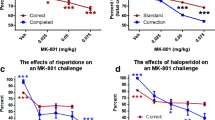Abstract.
Rationale: Early, accurate detection of degenerative neurological disorders such as Alzheimer's disease (AD) is essential for therapies designed to slow disease progression. Performance of a touch-screen mediated visuo-spatial paired-associates learning (vsPAL) task predicts neurocognitive decline in elderly populations presenting with mild cognitive impairment and distinguishes AD patients from elderly depressed individuals. Translation of this cognitive task to a non-human model may therefore provide an improved tool for study of the etiology and treatment of dementia. Objective: The goal of the current study was to contrast cholinergic and glutamatergic contributions to performance of this AD-sensitive task by challenging rhesus monkeys performing vsPAL with muscarinic antagonist and non-competitive NMDA antagonist drugs. Methods: Seven monkeys were trained to perform vsPAL and then serially challenged with acute doses of scopolamine (3, 10, 17 µg/kg, IM) and ketamine (0.3, 1.0, 1.78 mg/kg, IM). Results: Scopolamine produced a dose×difficulty related impairment of both recognition memory and incremental acquisition aspects of task performance. In contrast, ketamine administration resulted in a dose-dependent impairment of recognition memory but not incremental acquisition. Conclusions: Monkeys' performance of a task sensitive to AD in humans was impaired by two classic pharmacological models of cognitive impairment, therefore supporting the use of this nonhuman model to explore mechanisms of AD-associated cognitive decline. The differential pattern of impairment observed is consistent with a hypothesis that muscarinic mechanisms are required for linking external events with an existing internal representation, whereas NMDA mechanisms are required for the formation/strengthening of such an internal representation.
Similar content being viewed by others
Author information
Authors and Affiliations
Additional information
Electronic Publication
Rights and permissions
About this article
Cite this article
Taffe, M.A., Weed, M.R., Gutierrez, T. et al. Differential muscarinic and NMDA contributions to visuo-spatial paired-associate learning in rhesus monkeys. Psychopharmacology 160, 253–262 (2002). https://doi.org/10.1007/s00213-001-0954-5
Received:
Accepted:
Issue Date:
DOI: https://doi.org/10.1007/s00213-001-0954-5




